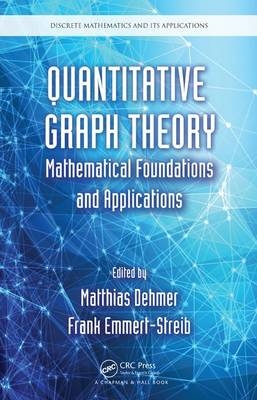
Quantitative Graph Theory
Crc Press Inc (Verlag)
978-1-4665-8451-8 (ISBN)
- Titel z.Zt. nicht lieferbar
- Versandkostenfrei
- Auch auf Rechnung
- Artikel merken
Comparative approaches (graph similarity or distance)
Graph measures to characterize graphs quantitatively
Applications of graph measures in social network analysis and other disciplines
Metrical properties of graphs and measures
Mathematical properties of quantitative methods or measures in graph theory
Network complexity measures and other topological indices
Quantitative approaches to graphs using machine learning (e.g., clustering)
Graph measures and statistics
Information-theoretic methods to analyze graphs quantitatively (e.g., entropy)
Through its broad coverage, Quantitative Graph Theory: Mathematical Foundations and Applications fills a gap in the contemporary literature of discrete and applied mathematics, computer science, systems biology, and related disciplines. It is intended for researchers as well as graduate and advanced undergraduate students in the fields of mathematics, computer science, mathematical chemistry, cheminformatics, physics, bioinformatics, and systems biology.
Matthias Dehmer studied mathematics and computer science at the University of Siegen, Germany, and earned his Ph.D in computer science from the Darmstadt University of Technology. He held research positions at the University of Rostock (Germany), Vienna Bio Center (Austria), Vienna Technical University (Austria), and University of Coimbra (Portugal), and obtained his habilitation in applied discrete mathematics from the Vienna University of Technology. His research focuses on investigating network-based methods in the context of systems biology, structural graph theory, operations research, and information theory. He has over 180 peer-reviewed publications, is an editor of a book series and a member of multiple editorial boards, and has co/organized several scientific conferences. Frank Emmert-Streib studied physics at the University of Siegen, Germany, and earned his Ph.D in theoretical physics from the University of Bremen. After postdoc positions in the United States, he joined the Center for Cancer Research and Cell Biology at the Queen’s University Belfast (United Kingdom), where he is currently an associate professor (senior lecturer) leading the Computational Biology and Machine Learning Laboratory. His research interests are in the fields of computational biology, biostatistics, and network medicine and are focused on the development and application of methods from statistics and machine learning for the analysis of high-dimensional data from genomics experiments.
What Is Quantitative Graph Theory?. Localization of Graph Topological Indices via Majorization Technique. Wiener Index of Hexagonal Chains with Segments of Equal Length. Metric-Extremal Graphs. Quantitative Methods for Nowhere-Zero Flows and Edge Colorings. Width-Measures for Directed Graphs and Algorithmic Applications. Betweenness Centrality in Graphs. On a Variant Szeged and PI Indices of Thorn Graphs. Wiener Index of Line Graphs. Single-Graph Support Measures. Network Sampling Algorithms and Applications. Discrimination of Image Textures Using Graph Indices. Network Analysis Applied to the Political Networks of Mexico. Social Network Centrality, Movement Identification, and the Participation of Individuals in a Social Movement: The Case of the Canadian Environmental Movement. Graph Kernels in Chemoinformatics. Chemical Compound Complexity in Biological Pathways.
| Erscheint lt. Verlag | 1.11.2014 |
|---|---|
| Verlagsort | Bosa Roca |
| Sprache | englisch |
| Maße | 156 x 234 mm |
| Gewicht | 1140 g |
| Themenwelt | Mathematik / Informatik ► Informatik ► Betriebssysteme / Server |
| Mathematik / Informatik ► Informatik ► Theorie / Studium | |
| Mathematik / Informatik ► Mathematik ► Allgemeines / Lexika | |
| Mathematik / Informatik ► Mathematik ► Graphentheorie | |
| Naturwissenschaften ► Biologie | |
| Technik ► Elektrotechnik / Energietechnik | |
| Technik ► Umwelttechnik / Biotechnologie | |
| ISBN-10 | 1-4665-8451-3 / 1466584513 |
| ISBN-13 | 978-1-4665-8451-8 / 9781466584518 |
| Zustand | Neuware |
| Haben Sie eine Frage zum Produkt? |
aus dem Bereich


